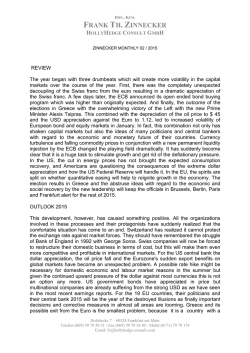
Euro area recommendations under the 2016 European Semester
IPOL DIRECTORATE-GENERAL FOR INTERNAL POLICIES EGOV ECONOMIC GOVERNANCE SUPPORT UNIT BRIEFING Euro area recommendations under the 2016 European Semester: An Overview This briefing provides an overview of the Council recommendations addressed to the euro area as a whole under the European Semester, including their implementation. Within the framework of the European Semester, the Council issues annual policy recommendations to the euro area as a whole based on Articles 121 and 136 of the Treaty of the Functioning of the European Union (TFEU). These recommendations typically cover fiscal, financial and structural issues as well as institutional aspects of the Economic and Monetary Union (EMU). Since the 2016 cycle, European Commission (COM) proposes draft recommendations to the euro area as a whole (as well as the accompanying Staff Working Document, SWD) at the start of the cycle (i.e. in November) along the Annual Growth Survey (AGS), the Alert Mechanism Report (AMR) and the draft Joint Employment Report (see the COM package of 26 November 2015). This means that draft euro area recommendations are now published six months ahead of draft Country Specific Recommendations (CSRs) proposed the COM in May for adoption by the Council in July. This new sequencing is to help better take into account euro area wide considerations in the design of national policies presented in Stability Programmes and National Reform Programmes. The 2016 recommendations proposed by the COM on 26 November 2015 were discussed and amended by the Council of 15 January 2016 and subsequently endorsed by the European Council of 18-19 February 2016 (see Annex 1). Finally, the Council is to formally adopt these recommendations on 8 March 2016. The Council and the Commission closely monitor the implementation of these recommendations and take further actions as appropriate. However, there is (1) no institutional body that bears formal responsibility for the implementation of euro area recommendations and (2) no formal mechanism to ensure implementation of these recommendations. The European Parliament (EP) is involved in the European Semester to increase its transparency and ownership, in particular by means of Economic Dialogues. The EP also contributes to the process via its resolutions (e.g. on implementation of 2014 priorities, 2015 AGS or draft report on 2016 AGS). 24 February 2016 Eurogroup work programme: 1st half of 2016 On 7 December 2015, the Eurogroup issued its indicative work programme for the first half of 2016. The agenda is mainly devoted to coordinating policy responses to bolster economic growth and job creation in the euro area. The Eurogroup will also: Contribute to strengthen the implementation of the European Semester; Continue to review macro-financial assistance programmes (EL, CY) and exert the related postprogramme surveillance (IE, PT, ES); Monitor the implementation of the EDP recommendations to euro area Member States; Hold discussions on the euro area fiscal stance and fiscal policy in a low interest rate environment, if warranted; Help to further develop the Banking Union, including better understanding and minimising risks within the Banking Union and working towards a level playing field; Prepare Euro Summit meetings, in particular providing input to discussions on deepening of the EMU; Foster consensus on the issue of external representation of the euro area. Author: M.Hradiský, contact: [email protected] PE 542.682 Euro area recommendations 2011-2016: A bird's eye view Table 1 below shows some stylised facts regarding euro area recommendations: Four broad policy areas have been typically covered under the European Semester over the period 2011-2016 (structural, fiscal, financial and institutional areas) while the design of the Semester has been evolving over time (see Annex 2 for the latest modifications). It is interesting to note that the institutional element (i.e. further deepening/completion of the EMU) was not part of the draft recommendations proposed by the Commission at the start of the 2016 cycle1. This institutional dimension has been subsequently introduced by the Council into the 2016 recommendations to the euro area (as the fifth recommendation); The number of recommendations to the euro area as a whole has varied over time. The latter had gradually declined from seven during the very first European Semester to four during the 2014 and 2015 cycles before increasing to five under the 2016 Semester. In particular, over the 2014 and 2015 cycles, the approach had consisted in addressing one recommendation per policy area. The 2016 vintage departs from this perspective, tackling the issue of structural reforms in two separate recommendations; As regards implementation2, the euro area as a whole made substantial or some progress on 100 % of the 2014 recommendations and 75 % of the 2015 recommendations. The only recommendation on which substantial progress has been made during those two vintages of the European Semester pertained to financial market reforms, including the Banking Union – an area where a policy action had become urgent as deep and prolonged economic crisis along with market pressure exposed weaknesses in the design of the EMU. On the other hand, the euro area as a whole implemented only to a limited extent structural reforms aiming at correcting macro-economic imbalances (first recommendation from 2015). Table 1: Council euro area recommendations - some stylized facts Number of recommendations 2011 2012 7 6 European Semester Cycle 2013 2014 6 2016 4 5 1. Structural 2. Fiscal 3. Financial 4. Institutional Policy areas covered Implementation (based on the COM assessment) 4 2015 Qualitative evaluation within Staff Working Documents but not in terms of a "standardised" assessment grid 1 (25%) 1 (25%) 3 (75%) 2 (50%) - 1 (25%) Due in November 2016 Sources: European Commission, Council and EGOV calculations. Note: For the sake of presentation, the assessment grid shown in the table is composed of three rather than five categories typically used by the Commission, namely 'full/substantial progress', 'some progress' and 'limited/no progress'. 1 Note that the COM adopted on 21 October 2015 a series of measures to implement the Stage 1 "Deepening by doing" of the EMU completion process outlined in the Five Presidents Report. 2 Based on the COM assessment of actions taken (rather than outcomes that may materialise with variable lags); assigning identical weights to all recommendations irrespective of their institutional and political sensitivities; and algebraically summing recommendations within each category, if applicable. PE 542.682 2 2016 Euro area recommendations: A closer perspective As already mentioned above, the Council 2016 recommendations to the euro area as a whole revolve around four main themes, namely: (1) Structural reforms; (2) Responsible fiscal policy; (3) Strengthening of banks' and private sector balance sheets and (4) Completion of the EMU. While these priorities have also been covered during the previous cycles, the emphasis placed on some elements has somewhat changed during the 2016 Semester, as depicted in Table 2 below. Note that (1) the 2016 AGS are fully reflected in the latest vintage of recommendations and (2) there is no one to one correspondence between AGS priorities and recommendations. Explicit reference to peer pressure as a mechanism to implement structural reforms: "Use peer pressure to promote structural reforms that facilitate the correction of large internal and external debt and support investment”. Recommendation to: “Pursue policies that support the recovery, facilitate the correction of macroeconomic imbalances and improve the adjustment capacity”. Explicit invitation addressed to Member States with large current account surpluses to: "implement as a priority measures, including structural reforms, that help strengthen their domestic demand and growth potential". Single recommendation in broad terms. Two recommendations, with the first providing a more general framework, while the second offers a more tailored advice, in particular, as regards several elements of labour market reform, yet leaving discretion to national authorities as to the design of policy actions. Fiscal Council 2016 euro area recommendations Unchanged in substance, with explicit reference to: "Pursue fiscal policies in full respect of the SGP"; "objective of broadly neutral fiscal stance" [for 2016]; Recommendation to maintain broadly neutral "Reduce public debt to restore fiscal buffers fiscal stance in the euro area [for 2015]. and avoid pro-cyclicality " [in view of 2017]; "Differentiate the fiscal effort by individual Member States ... taking into account the SGP requirements, while considering stabilisation needs as well as spillovers across the euro area countries". Financial Council 2015 euro area recommendations Recommendation to complete (additional elements of) the Banking Union, promote deeper market-based finance and encourage further reforms of national insolvency frameworks. Institutional Policy area Structural Table 2: Comparison of the 2015 and 2016 euro area recommendations Unchanged direction, but explicit emphasis on the full respect of the internal market and transparency: Take forward work on deepening of the "Work towards completing the EMU, in full EMU. respect of the internal market and in an open and transparent manner". No further reference to the completion of the Banking Union. Focus on "[facilitating] the gradual reduction of banks' non-performing loans and [improving] insolvency proceedings for businesses and households". Source: EGOV based on the 2015 and 2016 Council recommendations and the Commission 2016 Staff Working Document on the euro area. Note: The assessment grid for the 2015 euro area recommendations is composed of three rather than five categories typically used by the Commission, namely 'full/substantial progress', 'some progress' and 'limited/no progress'. 3 PE 542.682 Annex 1: Overview and assessment of 2015 and 2016 Council recommendations on the economic policy of the euro area Assessment of implementation of 2015 Recommendations (based on COM Staff Working Document) Council 2016 Recommendations (as endorsed by the European Council) The euro area has made limited progress in addressing CSR 1: 1. Pursue policies that support the recovery, foster convergence, facilitate the correction of macroeconomic imbalances and improve adjustment capacity. To this end, Member States, particularly those with large stocks of private and foreign debt, should implement reforms that enhance productivity, foster job creation, raise competitiveness and improve the business environment. Member States with large current account surpluses should implement as a priority measures, including structural reforms, that help strengthen their domestic demand and growth potential. Council 2015 Recommendations 1. Use peer pressure to promote structural reforms that facilitate the correction of large internal and external debts and support investment. Regularly assess the delivery of reforms in those Member States which require specific monitoring within the framework of the Macroeconomic Imbalances Procedure. Continue the regular thematic assessment of structural reforms. By spring 2016, take decisions on the follow-up to the coordination exercise on reducing the high tax wedge on labour and on reforming services markets. 2. Coordinate fiscal policies to ensure that the aggregate euro area fiscal stance is in line with sustainability risks and cyclical conditions. This is without prejudice to the fulfilment of the requirements of the Stability and Growth Pact. By spring 2016, hold thematic discussions on improvements in the quality and sustainability of public finances, focussing in particular on PE 542.682 Progress in delivering reform commitments has been promoted at the euro area level, via i.a. technical discussions in Economic Policy Committee and Economic and Financial Committee and political discussion in Eurogroup and ECOFIN. Programme countries' reform progress, as well as discussion on reform progress in member states with excessive imbalances or imbalances requiring decisive action, has also taken place. The Eurogroup has held thematic discussions on reducing the high tax wedge on labour, inter alia agreeing on a benchmarking exercise, as well as on reforming services markets. The euro area has made some progress in addressing CSR 2: Assessments of the euro area fiscal stance have been carried by the Eurogroup, notably by reviewing the implementation of the Two-pack and discussing the implications of the Commission services' autumn 4 2. Implement reforms that combine (i) flexible and reliable labour contracts that promote smooth labour market transitions and avoid a two-tier labour market; (ii) comprehensive lifelong learning strategies; (iii) effective policies to help the unemployed re-enter the labour market, (iv) adequate and sustainable social protection systems that contribute effectively and efficiently throughout the life cycle both to social inclusion and labour market integration and, (v) open and competitive product and services markets. Reduce the tax wedge on labour, particularly on low-earners, in a budgetaryneutral way to foster job creation. 3. Pursue fiscal policies in full respect of the Stability and Growth Pact. For 2016, the objective of a broadly neutral aggregate fiscal stance in the euro area appears appropriate in order to reflect a balance between long-term fiscal sustainability and short-term macroeconomic stabilisation. With a view to 2017, reduce public debt to restore fiscal buffers and avoid pro-cyclicality. the prioritisation of tangible and intangible investment at national and EU levels, and on making tax systems more growth friendly. Monitor the effective functioning of the recently strengthened national fiscal frameworks. 3. Ensure the timely finalisation of the follow up of the Comprehensive Assessment carried out by the European Central Bank, implementation of Directive 2014/59/EU of the European Parliament and of the Council (1) (Bank Recovery and Resolution Directive), completion of the ratification of the Intergovernmental Agreement on the Single Resolution Fund and make the Fund fully operational as from January 2016. Promote measures to deepen market-based finance, to improve access to finance for SMEs and to develop alternative sources of finance. Encourage further reforms of national insolvency frameworks. 2013 and 2015 forecast for fiscal surveillance. The Eurogroup has held thematic discussions on fiscal frameworks. In the EMU Package on 21 October 2015, the Commission published its decision to set up an European Fiscal Board to act as an independent advisory body. Its mandate will include to evaluate how fiscal governance framework was implemented, to advise on the euro area fiscal stance and to cooperate with the national fiscal councils. Some progress has been made on the coordination of fiscal policies, in particular in the context of the assessment of the draft budgetary plans, to the extent that fiscal outlook for the euro area as a whole has improved and the aggregate fiscal stance seems appropriate. However, the distribution of the fiscal stance remains sub-optimal. The euro area has made substantial progress in addressing CSR 3: The ECB Single Supervisory Mechanism (SSM) became fully operational and responsible for direct supervision of the most significant euroarea banks. The asset quality review (the comprehensive assessment) of 130 banks was completed and the SSM started work towards further harmonisation of bank supervisory and regulatory treatment across the euro area. The establishment of the Single Resolution Board (SRB) and of the Single Resolution Fund (SRF) advanced according to plans in 2015. Work also progressed towards agreeing bridge financing arrangements for the SRF and towards the establishment of a common backstop for the SRF during the transition period. 5 Differentiate the fiscal effort by individual Member States in line with their respective positions vis-à-vis the requirements under the SGP while considering stabilisation needs, as well as taking into account possible spillovers across euro area countries. To this end, review the euro area fiscal stance in the context of the Stability Programmes and the Draft Budgetary Plans. 4. Facilitate the gradual reduction of banks' nonperforming loans and improve insolvency proceedings for businesses and households. In Member States with large stocks of private debt, promote an orderly deleveraging, including by facilitating the resolution of unviable private debt. PE 542.682 4. Take forward work on deepening Economic and Monetary Union, and contribute to the improvement of the economic surveillance framework in the context of the report on the next steps on better economic governance in the euro area, prepared by the President of the European Commission, Jean-Claude Juncker, in close cooperation with the President of the European Council, Donald Tusk, the President of the European Parliament, Martin Schulz, the President of the European Central Bank, Mario Draghi, and the President of the Eurogroup, Jeroen Dijsselbloem, and its follow-up. PE 542.682 On 30 September 2015 the Commission launched the Capital Markets Union (CMU) Action Plan, aiming at boosting business funding and investment financing by building a single market for capital across the EU. This initiative will enable the development of alternative sources of finance complementary to bankfinancing and to break down barriers blocking crossborder investments in the EU. CMU should be particularly beneficial to SMEs and start-ups. Preparatory work has started and consultations are gearing up towards a legislative proposal for principles-based minimum harmonisation of business insolvency. The euro area has made some progress in addressing CSR 4: On 21 October 2015 the Commission adopted a package of measures to further strengthen and deepen the Economic and Monetary Union. It followed up on the Five Presidents' Report published in June, which was based on a wide consultation with the Member States. The package proposals included measures to revamp the EU Semester, in particular by strengthening its euro area dimension, it presented proposals for an improved toolbox of economic governance, including a recommendations to establish national Competitiveness Boards and a proposal for a more consistent external representation of the euro area. 6 5. Work towards completing the Economic and Monetary Union, in full respect of the internal market and in an open and transparent manner, further exploring the legal, economic and political aspects of the more long-term measures contained in the Five Presidents' Report. Annex 2: Revamped European Semester The European Semester has been substantially streamlined since last year, including 1) a single assessment per Member State, 2) re-focused and fewer CSRs, 3) an earlier publication of Country Specific Reports and 4) wider dialog with stakeholders at all levels. As announced in the Commission Communication of 21 October 2015, the design of the European Semester will be further revised from the 2016 Cycle to: Better integrate the euro area and national dimensions The European Semester, which runs from November to June, will be now sequenced in two successive phases - a European phase (from November to February) and a national phase (from February to June). This new sequencing is to help to (1) better take account of challenges to the whole euro area since the start of the cycle and subsequently (2) integrate this analysis in the design of national policies. Therefore, from the 2016 European Semester onwards, the Commission is publishing its proposal for recommendations for the euro area as a whole and its assessment of the implementation of the recommendations from the previous cycle along the AGS; Stronger focus on employment and social performance To better integrate employment and social aspects within the MIP, three new indicators have been added to the Scoreboard, namely: activity rate, youth unemployment and long-term unemployment. At the same time, the Commission is to pay greater attention to social fairness in the design of macroeconomic adjustment programmes; Promoting convergence by benchmarking and pursuing best practices The Five Presidents Report highlighted that common standards could help to foster economic convergence towards more resilient economic structures. Consequently, the Commission will progressively develop benchmarks and the exchange of best practices across policy areas, building on the existing thematic analysis developed with the Member States. This crossexamination against a particular benchmark of indicators related to economic and social performance and policies in each Member State is seen as a useful tool to (1) identify underperformance/need for action at an early stage, (2) monitor progress and (3) effectively communicate the results of policy action. The Commission considers that benchmarking can contribute to increasing the ownership of the structural reforms by the Member States and therefore their implementation; More focused support to reforms through EU funds and technical assistance This year AGS is accompanied by a Commission proposal for establishment of the Structural Reform Support Programme for the period 2017-2020. This Programme is to contribute to institutional, administrative and structural reforms in the Member States, including through assistance for the efficient and effective use of the EU funds. DISCLAIMER: This background note is drafted by the Economic Governance Support Unit (EGOV) of the European Parliament based on publicly available information and is provided for information purposes only. The opinions expressed in this document are the sole responsibility of the authors and do not necessarily represent the official position of the European Parliament. Reproduction and translation for non-commercial purposes are authorised, provided the source is acknowledged and the publisher is given prior notice and sent a copy. © European Union, 2016 7 PE 542.682
© Copyright 2025





